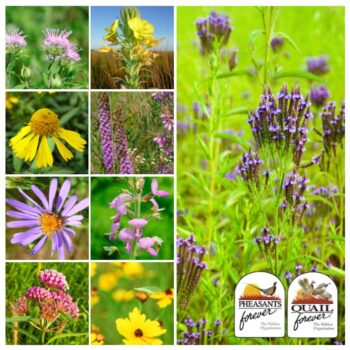Description
| GRASSES | 49% (11.798 PLS/ft2) |
| Big Bluestem, Pawnee | Sideoats Grama, Butte |
| Indiangrass, Neb 54 | Slender Wheatgrass |
| Little Bluestem, Aldous | Western Wheatgrass, Barton |
| Prairie Junegrass | |
| WILDFLOWERS | 51% (12.066 PLS/ft2) |
| Alfalfa, VNS | Lemon Mint |
| Alsike Clover | New England Aster |
| Blackeyed Susan | Pale Purple Coneflower |
| Butterfly Milkweed | Partridge Pea |
| Canada Milkvetch | Pitcher or Blue Sage |
| Canada Tick-trefoil | Purple Coneflower |
| Common Evening Primrose | Purple Prairieclover |
| Common Milkweed | Rough Gayfeather |
| Cudweed Sagewort | Roundhead Lespedeza |
| Dotted Gayfeather | Shell-leaf Penstemon |
| Engelmann’s Daisy | Stiff Goldenrod |
| Foxglove Beardstongue | Stiff Sunflower |
| Golden Alexander | Thickspike Gayfeather |
| Grayhead Coneflower | Western Yarrow |
| Hoary Vervain | Wild Bergamot |
| Illinois Bundleflower | |
| TOTAL: 23.864 PLS/ft2 |
Wildlife Cover Requirements
Cover is critical because pheasants and quail depend on a variety of cover types (nesting, brood-rearing, winter) for population growth and survival. Ideally, a mix of warm-season bunchgrasses (e.g., big bluestem, little bluestem), forbs (broadleaf plants), and legumes (clover, alfalfa) provide nesting and brood-rearing cover. Landowners seeking to maintain or increase pheasant and quail populations should ensure that all of the essential habitat needs (food, cover, water, space) are available and easily-accessible in close proximity. Throughout the pheasant range, nesting cover is the single most important limiting factor for populations. Thankfully, it remains one of the few factors we can directly impact through habitat management and improvements. To learn more, visit the Habitat Essentials page.
The Habitat Organization
Pheasants Forever’s mission is to conserve pheasants, quail, and other wildlife through habitat improvements, public access, education, and conservation advocacy.







